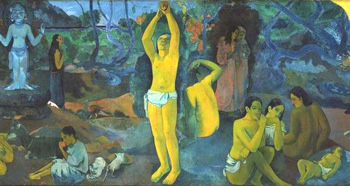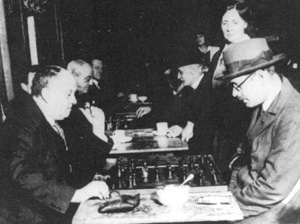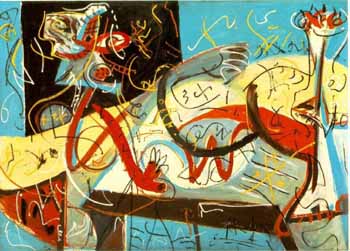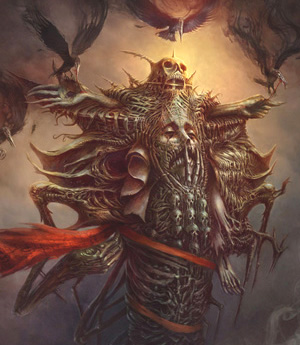 |
Art & Architecture
The Modern Art's Kabala
Cunha Alvarenga
In a previous article, I referred to the ‘coincidence’ that the modern art currents emerged at the same time as the spiraling of magic and the occult ‘sciences’ in the 19th century. The apparently sporadic occurrence of cabalistic themes in literary works became almost systematic as the Enlightenment approached, such as in the works of Milton in the 17th century or in those of Goethe in the 18th century.
The Romanticism and the Symbolism of the 19th century, for example, developed simultaneously to the escalating influence of magic and occult. These movements were not just the fruit of the individual esoteric bent of a Victor Hugo in France, a Guerra Junqueiro in Portugal or an Alvares de Azevedo in Brazil. Nor were they simply a consequence of the occult divagations of a Charles Baudelaire, a Eugenio de Castro or a Cruz e Souza. Rather they represented a whole artistic and literary movement that derived from the new impulse given to the Gnostic sects.
Several currents of modern art share with Socialism the same political goal of a classless society and the utopist ideal of implanting a chiliast kingdom on earth. This shared end indicates a common doctrinal background and cult, which they named Transcendent Pantheism. This supposed creed of magic and occult inspired religious syncretism, which serves to trigger Socialism. As we know Socialism - or Social Pantheism - always follows Religious Pantheism, which is connected to the Gnostic thinking that has infected almost all the heresies since the Apostolic Age.

Gaugin explored pagan magic and rituals in the Polynesia Islands |
While, for a Catholic, art is linked to an ideal of elevation and beauty, for a partisan of these modern currents, art is something different. Artistic skill and talent become means to disseminate shadowy mysteries and to impose social domination.
It was his involvement in magic and false mysticism that led Gauguin to the French Polynesia Islands in the South Pacific to learn native ritual and witchcraft. Similar hermetic influences generated the birth of the pre-Raphaelist Brotherhood movement in England, whose leader was poet and painter Dante Gabriel Rossetti. His works were heavily imbued with the occult.
Cubism, Futurism, Expressionism, Dadaism, Suprematism, Surrealism, Orphism, Abstractionism, Concretism – these are some of the different names assumed by this artistic kabala in the 20th century.
An effort to dominate others
We can better understand this subversion in art by showing how the Portuguese poet Fernando Pessoa expounded its fundamental principles. In his work Notes for a Non-Aristotelian Aesthetics, he sought an aesthetics based on force and energy, not on truth and beauty. He pretends that since art is a social phenomenon, it “is above all an effort to dominate others.”

Fernando Pessoa, right, met his mentor Aleister Crowley once in Lisbon in 1930 |
Pessoa explains that while Aristotelian art influences by convincing, modern art dominates by subjugating. He continues: “The first, Aristotelian art, bases itself on the concept of beauty because it wants to make what pleases; it bases itself on intelligence because it wants to make what is comprehensible. The second, modern art, is based on feeling, which is specific and personal. It is through this personal feeling that we dominate; otherwise, to dominate would be to lose one’s personality or, in other words, to be dominated.”
Even before the Surrealists, Fernando Pessoa was already composing his poetry in a state of trance. He became a medium and joined Spiritism. He was initiated in theosophy by Anne Besant and Madame Blavatsky and corresponded with the famous warlock Aleister Crowley. (1) He claimed to discover in the “holy” kabala “the source of all enlightenment and all esoteric philosophy.”
According to him, “Gnosticism, Neo-Platonism, Theosophy, Spiritism, Occultism - everything leads to the same conclusion: the meaning of the world, the explanation of life and of death itself belong to those initiated into the mysteries of the Occult.” (2)
These notions of force and of social domination weld the alliance between Futurism and Fascism, or the Socialism of the right. As a natural ally, Mussolini gave Marinetti, the Italian initiator of the Futurist movement, the title “Saint John Baptist of Fascism.”
Methods of modern art
What should we say about the methods of modern art? On this topic I offer the opinion of French scholar Maurice Nadeau in his work The History of Surrealism. Nadeau says:
“The methods of Surrealism constitute a true revolution. First, Surrealism denies poetry by trying to surpass it. In poetry order is eliminated to leave room for the spontaneous text, the pure and simple dictates of the unconscious, the narrative of the dream. There is no artistic concern for the quest of beauty. Importance is given to what is vile and undignified.

A psycho-transmitted painting by Jackson Pollock |
"The spirit of the poet is what it is: havoc where sensations, sentiments, desires and hopes intermingle and are expressed in the tumult - incoherence through the spoken word and the pen. … By means of radical destruction, the Surrealist poets constructed ‘new values’ in the [chaotic] atmosphere of the world’s creation.
“This revolution in poetry became possible through an inner revolution in man and his relations with the world. … The Marquis of Sade is the central figure in its Pantheon. [Sade was a French poet and libertine who delivered himself to the most corrupt sexual cruelties with others; from his name came the term sadism.] Surrealism wants to destroy the whole legacy transmitted by the family, morals and religion. French Communist poet Louis Aragon said: ‘Laws, morals and aesthetics were created to impose respect for the weak. It is necessary to break free from what is weak. Our heroes are Viollette Nozière who murdered her parents, the anonymous criminal, the deliberately sacrilegious man’ (Les Aventures de Télémaque).
“The old traditional opposition between the bourgeois and the artist was replaced by a violent antagonism between the revolutionary and the owner, the slave and the boss. While the Surrealists started with a mystic idealism of the predominance of spirit over matter, they ended in revolutionary materialism.” (3)
These words of Nadeau about Surrealism could also be applied to other currents of modern art and Gnostic movements in our contemporary history.
Demonic inspiration
What is this automatic painting, this abandonment to the instincts of the unconscious, this quest for the monstrous, the negative and the infra-natural?

Surrealist painting titled Demonic Despair reveals the inspiration behind the movement |
What is this delivering of oneself to hallucinations and the madness that led many of these ‘geniuses’ to commit suicide? What is this degradation that imitates the barbarianism of the savage, the immature imagination of the child or the grotesque improvisations of the clown?
All of this would seem to be nothing more than symptoms of delivering one’s free will to the Devil…
Entering the underlying depths of this artistic kabala, Austrian scholar of modern art Hans Seldmayr concurs: “I affirm that in no other period of the history of man has demonic art dominated as it does in our days, to the extent that the very image of man has become demonized.” (4)
I believe that this reference to modern art applied to its different schools should be a criterion to help us appraise such works whenever we encounter them.
1. Aleister Crowley was called “the filthiest and more perverse English man” by a British judge. Asked about who he was, he answered: “Before Hitler was, I am.” This Satanist, who died in December 2, 1947, founded two magazines in Berlin - Gnosis and Lucifer - between 1920 and 1922. At his funeral his disciples sang over his grave the Hymn to Pan composed by Crowley himself, the Hymn to Satan by Carducci and the Collection for a Gnostic Mass, composed by Crowley as well for his satanic temple in London. Fernando Pessoa translated the Hymn to Pan into Portuguese. Cfr Alois Mager, Satan de nos jours.
2. See the chapters “Esoteric Initiation” and “The Holy Kabala” in J. Gaspar Simões, Vida e Obra de Fernando Pessoa, 2 vols. 3. Maurice Nadeau, Histoire du Surréalism 4. Hans Seldmayr, Art du demoniaque et demonie de l’art. See also Filosofia dell’arte published by Centro Internazionale di Studi Umanistici. On the Gnostic origin of modern music, see Roman Vlad, Demonicità e dodecafonia.

Published in Catolicismo n. 34, October, 1953
Translated and adapted by TIA desk
Posted August 8, 2011

Related Topics of Interest
 Esoteric Characteristics of Modern Art Esoteric Characteristics of Modern Art
 Abstract Art & Theosophy Abstract Art & Theosophy
 Modern Art, Socialism & Marxism Modern Art, Socialism & Marxism
 Immoral and Extravagant Art Expo in Brussels Immoral and Extravagant Art Expo in Brussels
 The Taste for the Macabre in Today's Art The Taste for the Macabre in Today's Art
 Trash Art at St. Mary Magdalene Church Trash Art at St. Mary Magdalene Church
 The Subtle Invasion of Satanism The Subtle Invasion of Satanism
 John Lennon’s Pact with Satan John Lennon’s Pact with Satan

Related Works of Interest
|
|
Art & Architecture | Hot Topics | Home | Books | CDs | Search | Contact Us | Donate

© 2002-
Tradition in Action, Inc. All Rights Reserved
|
 |

|